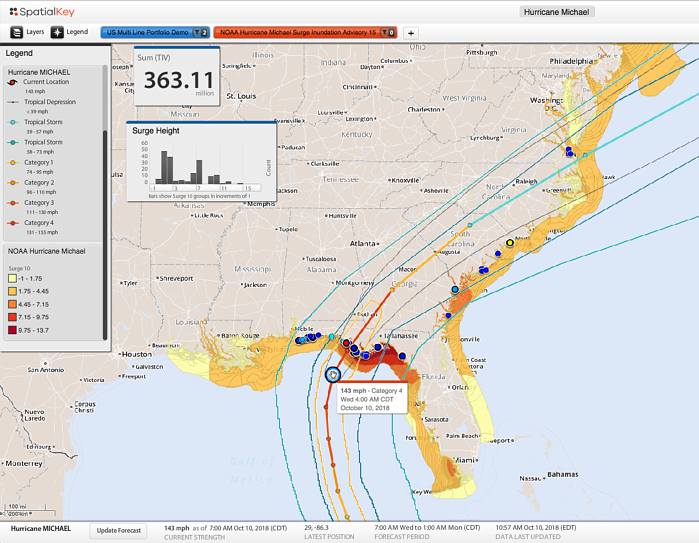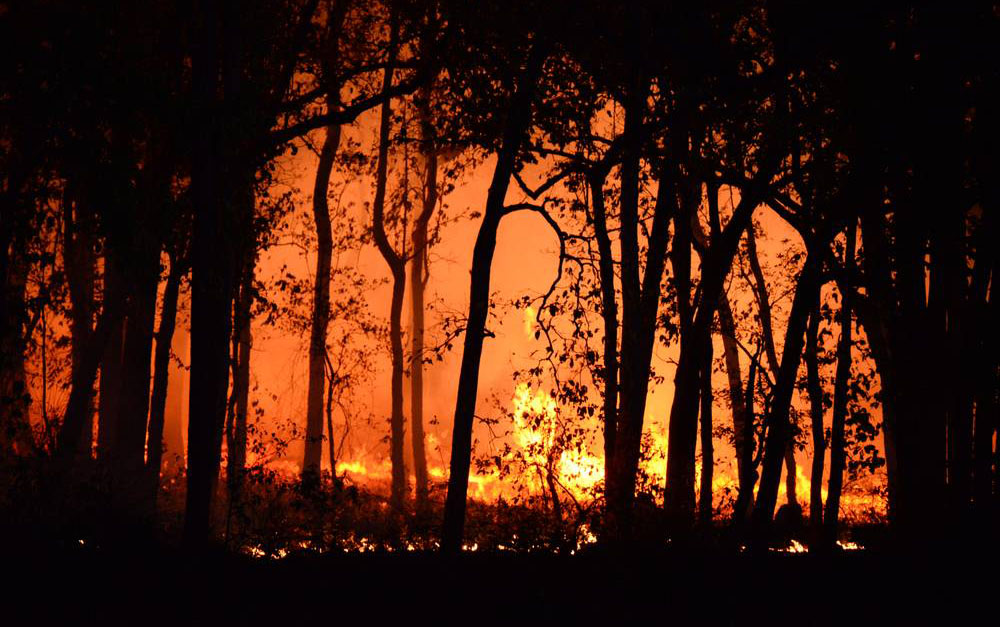The ecosystem of hazard models and data is rapidly expanding, and this is exciting news for the P&C industry. But with all the hazard data that is being generated, especially during catastrophic events like hurricane and wildfire, comes the need for a more streamlined way to access it.
Data quality and modeling is continually improving—more accuracy, better science, higher resolution—which we have witnessed here at
SpatialKey working with providers like
KatRisk,
JBA,
RedZone,
Swiss Re, Impact Forecasting,
HazardHub and a host of others for a number of years now.
But while the quality and quantity of data in the market is abundant, some carriers are lagging behind when it comes to accessing and interpreting these models because their systems are disjointed and outdated. Accessing data from disparate sources, or “system hopping,” delays response time and can sabotage a carrier’s downstream customer satisfaction.
Three key challenges that insurance organizations face related to the accessibility of hazard data are:
- Disparate solutions and proprietary formats
- Access to hazard data during time-sensitive events
- Ability to compare multiple views of risk
Let’s take a closer look at the impact of these challenges and what can be done to solve them:
1) Problem: Disparate solutions and proprietary formats
While data choice is abundant, you may find that you’re still hopping between platforms to access and visualize hazard data and models in the context of your exposure data. A key reason for this is the
proprietary nature of some trusted industry catastrophe models. They can drive inefficiencies by limiting where data can be visualized and how. This leads to the necessity of piecing together multiple disparate solutions to fully understand the extent of an event. Without the ability to quickly and efficiently calibrate views of risk, you’ll be left with more questions than answers.
Solution: Rather than visiting multiple platforms to piece together the impact of an event relative to exposures, leverage multiple views of risk via a single platform—while having them in-hand sooner. This way, you can better estimate losses and allocate your event response resources.
See also: Effects of Weather Are Gathering Force
2) Problem: Access to hazard data during time-sensitive events
Timely procurement of trusted and up-to-date footprints during the course of an event can also be a challenge without a centralized solution to access data and contextualize it with advanced analytics and visualization tools. Data providers like KatRisk, JBA and Impact Forecasting, in particular, are generating their views of risk well ahead of an event and before many other data providers. A comprehensive view of an event means having data readily in-hand before, during and after an event—and preferably via a single solution where you can compare multiple footprints in the context of your portfolio data.
Solution: Quickly integrate data from both private and public sources, so you can quickly extract insight from it—and get back to the more important aspects of event response, especially customer outreach.
3) Problem: Lack of ability to compare multiple views of risk
The ability to compare multiple hazards and models in one place is increasingly important with complex events like hurricane, which involve multiple perils (i.e. wind, surge, flood) from multiple providers. While more views of risk can be a benefit, you can quickly hit information paralysis.
Which model got it right? Which model is closest to my organization's view of risk? As we’re all aware,
models and their outputs are nuanced. Decisions come down to identifying the right models and model components that best represent your lines of business, geography and business practices.
During Hurricane Michael, for example, our clients had access to event footprints for wind, surge and inland flood around-the-clock from expert data providers. These up-to-date, multi-peril footprints, coupled with our financial modeling, could be evaluated and compared in real time, helping clients understand potential exposure and
ready response efforts.
 This pre-landfall view of Hurricane Michael from within SpatialKey is showing NOAA surge and wind bands overlaid with sample portfolio data. NOAA updates are available approximately every four hours during hurricanes, along with regular updates from expert providers like KatRisk, JBA, Impact Forecasting and others. This enables you to view and compare multiple models from within SpatialKey for a more comprehensive understanding of an event.
Solution:
This pre-landfall view of Hurricane Michael from within SpatialKey is showing NOAA surge and wind bands overlaid with sample portfolio data. NOAA updates are available approximately every four hours during hurricanes, along with regular updates from expert providers like KatRisk, JBA, Impact Forecasting and others. This enables you to view and compare multiple models from within SpatialKey for a more comprehensive understanding of an event.
Solution: A platform like SpatialKey helps you assess if a model is the right fit for your business—enabling you to step through methodology and figure out the questions that models provoke but don’t answer. Hurricanes and wildfires, in particular, expedite the need to evaluate footprints to understand the business impact, as deriving insights is extremely time-sensitive. For example, you may be interested in the geographic boundary of a major flood to get boots on the ground. Or, you may want to understand the gauge readings (rain, river, surge measurements, etc.) in an effort to process and validate claims.
It’s time to streamline your access to expert data
Event response is a time-consuming effort, and it’s when speed and efficiency are needed most. In the early days of an event, you need to know how you and your customers will be affected and to what extent. But, you may feel like you have no time to get answers to stakeholders—and having to hop between disparate sources only delays your understanding. You need to streamline your access to expert data while providing a centralized location to compare views of risk and visualize data in the context of your portfolio.
See also: Turning Data Into Action
Now, with just one place to access and analyze data during time-sensitive events, you have...
- Increased your operational efficiency by reducing (or eliminating) disparate solutions.
- Streamlined your access to the most up-to-date footprints and models.
- Increased your understanding of risk with the ability to compare multiple hazards and models via a single solution.
- Gained an immediate understanding of your actual financial impact (so your stakeholders are happy).
- Focused your resources on what matters most: mitigation and customer outreach.
In Part 2 of this series, we’ll discuss how you can spend less time processing hazard data and more time driving better decisions.  This pre-landfall view of Hurricane Michael from within SpatialKey is showing NOAA surge and wind bands overlaid with sample portfolio data. NOAA updates are available approximately every four hours during hurricanes, along with regular updates from expert providers like KatRisk, JBA, Impact Forecasting and others. This enables you to view and compare multiple models from within SpatialKey for a more comprehensive understanding of an event.
Solution: A platform like SpatialKey helps you assess if a model is the right fit for your business—enabling you to step through methodology and figure out the questions that models provoke but don’t answer. Hurricanes and wildfires, in particular, expedite the need to evaluate footprints to understand the business impact, as deriving insights is extremely time-sensitive. For example, you may be interested in the geographic boundary of a major flood to get boots on the ground. Or, you may want to understand the gauge readings (rain, river, surge measurements, etc.) in an effort to process and validate claims.
It’s time to streamline your access to expert data
Event response is a time-consuming effort, and it’s when speed and efficiency are needed most. In the early days of an event, you need to know how you and your customers will be affected and to what extent. But, you may feel like you have no time to get answers to stakeholders—and having to hop between disparate sources only delays your understanding. You need to streamline your access to expert data while providing a centralized location to compare views of risk and visualize data in the context of your portfolio.
See also: Turning Data Into Action
Now, with just one place to access and analyze data during time-sensitive events, you have...
This pre-landfall view of Hurricane Michael from within SpatialKey is showing NOAA surge and wind bands overlaid with sample portfolio data. NOAA updates are available approximately every four hours during hurricanes, along with regular updates from expert providers like KatRisk, JBA, Impact Forecasting and others. This enables you to view and compare multiple models from within SpatialKey for a more comprehensive understanding of an event.
Solution: A platform like SpatialKey helps you assess if a model is the right fit for your business—enabling you to step through methodology and figure out the questions that models provoke but don’t answer. Hurricanes and wildfires, in particular, expedite the need to evaluate footprints to understand the business impact, as deriving insights is extremely time-sensitive. For example, you may be interested in the geographic boundary of a major flood to get boots on the ground. Or, you may want to understand the gauge readings (rain, river, surge measurements, etc.) in an effort to process and validate claims.
It’s time to streamline your access to expert data
Event response is a time-consuming effort, and it’s when speed and efficiency are needed most. In the early days of an event, you need to know how you and your customers will be affected and to what extent. But, you may feel like you have no time to get answers to stakeholders—and having to hop between disparate sources only delays your understanding. You need to streamline your access to expert data while providing a centralized location to compare views of risk and visualize data in the context of your portfolio.
See also: Turning Data Into Action
Now, with just one place to access and analyze data during time-sensitive events, you have...








